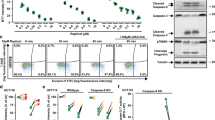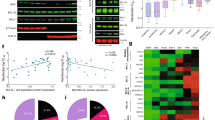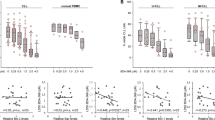Abstract
The importance of Bax for induction of tumor apoptosis through death receptors remains unclear. Here we show that Bax can be essential for death receptor–mediated apoptosis in cancer cells. Bax-deficient human colon carcinoma cells were resistant to death-receptor ligands, whereas Bax-expressing sister clones were sensitive. Bax was dispensable for apical death-receptor signaling events including caspase-8 activation, but crucial for mitochondrial changes and downstream caspase activation. Treatment of colon tumor cells deficient in DNA mismatch repair with the death-receptor ligand apo2 ligand (Apo2L)/tumor necrosis factor-related apoptosis-inducing ligand (TRAIL) selected in vitro or in vivo for refractory subclones with Bax frameshift mutations including deletions at a novel site. Chemotherapeutic agents upregulated expression of the Apo2L/TRAIL receptor DR5 and the Bax homolog Bak in Bax−/− cells, and restored Apo2L/TRAIL sensitivity in vitro and in vivo. Thus, Bax mutation in mismatch repair–deficient tumors can cause resistance to death receptor–targeted therapy, but pre-exposure to chemotherapy rescues tumor sensitivity.
This is a preview of subscription content, access via your institution
Access options
Subscribe to this journal
Receive 12 print issues and online access
$209.00 per year
only $17.42 per issue
Buy this article
- Purchase on Springer Link
- Instant access to full article PDF
Prices may be subject to local taxes which are calculated during checkout






Similar content being viewed by others
Accession codes
References
Ashkenazi, A. & Dixit, V.M. Death receptors: signaling and modulation. Science 281, 1305–1308 (1998).
Green, D. Apoptotic pathways: paper wraps stone blunts scissors. Cell 102, 1–4 (2000).
Li, H., Zhu, H., Xu, C.-J. & Yuan, J. Cleavage of BID by caspase 8 mediates the mitochondrial damage in the Fas pathway to apoptosis. Cell 94, 491–501 (1998).
Luo, X., Budihardjo, I., Zou, H., Slaughter, C. & Wang, X. Bid, a Bcl2 interacting protein, mediates cytochrome c release from mitochondria in response to activation of cell surface death receptors. Cell 94, 481–490 (1998).
Gross, A. et al. Caspase cleaved Bid targets mitochondria and is required for cytochrome c release, while Bcl-XL prevents this release but not tumor necrosis factor-R1/Fas death. J. Biol. Chem. 274, 1156–1163 (1999).
Roy, S. & Nicholson, D. Cross-talk in cell death signaling. J. Exp. Med. 192, F21–F25 (2000).
Eskes, R., Desagher, S., Antonsson, B. & Martinou, J. Bid induces the oligomerization and insertion of Bax into the outer mitochondrial membrane. Mol. Cell. Biol. 20, 929–935 (2000).
Wei, M. et al. tBID, a membrane targeted death ligand, oligomerizes Bak to release cytochrome c. Genes Dev. 14, 2060–2071 (2000).
Yin, X.-M. et al. Bid-deficient mice are resistant to Fas-induced hepatocellular apoptosis. Nature 400, 886–891 (1999).
Lindsten, T. et al. The combined functions of proapoptotic Bcl-2 family members Bak and Bax are essential for normal development of multiple tissues. Molec. Cell 6, 1389–1399 (2000).
Wei, M.C. et al. Proapoptotic BAX and BAK: a requisite gateway to mitochondrial dysfunction and death. Science 292, 727–730 (2001).
Nicholson, D.W. From bench to clinic with apoptosis-based therapeutic agents. Nature 407, 810–816 (2000).
Lengauer, C., Kinzler, K. & Vogelstein, B. Genetic instabilities in human cancers. Nature 396, 643–649 (1998).
Rampino, N. et al. Somatic frameshift mutations in the BAX gene in colon cancers of the microsatellite mutator phenotype. Science 275, 967–969 (1997).
Zhang, L., Yu, J., Park, B., Kinzler, K. & Vogelstein, B. Role of BAX in the apoptotic response to anticancer agents. Science 290, 989–992 (2000).
Ionov, Y., Yamamoto, H., Krajewski, S., Reed, J.C. & Perucho, M. Mutational inactivation of the proapoptotic gene Bax confers selective advantage during tumor clonal evolution. Proc. Natl. Acad. Sci. USA 97, 10872–10877 (2000).
Perucho, M. Cancer of the microsatellite mutator phenotype. Biol. Chem. 377, 675–684 (1996).
Kischkel, F.C. et al. Cytotoxicity-dependent APO-1 (Fas/CD95)-associated proteins form a death-inducing signaling complex (DISC) with the receptor. EMBO J. 14, 5579–5588 (1995).
Kischkel, F.C. et al. Apo2L/TRAIL-dependent recruitment of endogenous FADD and caspase-8 to death receptors 4 and 5. Immunity 12, 611–620 (2000).
Sprick, M.R. et al. FADD/MORT1 and Caspase-8 are recruited to TRAIL receptors 1 and 2 and are essential for apoptosis mediated by TRAIL receptor 2. Immunity 12, 599–609 (2000).
Bodmer, J.L. et al. TRAIL receptor-2 signals apoptosis through FADD and caspase-8. Nature Cell Biol. 2, 241–243 (2000).
Boldin, M., Goncharov, T., Goltsev, Y. & Wallach, D. Involvement of MACH, a novel MORT1/FADD-interacting protease, in FAS/APO-1-and TNF receptor-induced cell death. Cell 85, 803–815 (1996).
Muzio, M. et al. FLICE, a novel FADD-homologous ICE/CED-3-like protease, is recurited to the CD95 (Fas/APO1) death-inducing signaling complex. Cell 85, 817–827 (1996).
Evan, G. & Littlewood, T. A matter of life and cell death. Science 281, 1317–1322 (1998).
Wu, G.S. et al. KILLER/DR5 is a DNA damage-inducible p53-regulated death receptor gene. Nature Genet. 17, 141–143 (1997).
Scaffidi, C. et al. Differential modulation of apoptosis sensitivity in CD95 type I and type II cells. J. Biol. Chem. 274, 22532–22538 (1999).
Pitti, R. et al. Genomic amplification of a decoy receptor for Fas ligand in lung and colon cancer. Nature 396, 699–703 (1998).
Djerbi, M. et al. The inhibitor of death receptor signaling, FLICE-inhibitory protein defines a new class of tumor progression factors. J. Exp. Med. 190, 1025–1031 (1999).
Medema, J., de Jong, J., van Hall, T., Melief, C. & Offringa, R. Immune escape of tumors in vivo by expression of cellular FLICE-inhibitory protein. J. Exp. Med. 190, 1033–1038 (1999).
Ashkenazi, A. et al. Safety and anti-tumor activity of recombinant soluble Apo2 ligand. J. Clin. Invest. 104, 155–162 (1999).
Lawrence, D. et al. Differential hepatocyte toxicity of recombinant Apo2L/TRAIL versions. Nature Med. 7, 383–385 (2001).
Qin, J.Z., Chaturvedi, V., Bonish, B. & Nickoloff, B.J. Avoiding premature apoptosis of normal epidermal cells. Nature Med. 7, 385–386 (2001).
Ashkenazi, A. & Dixit, V.M. Apoptosis control by death and decoy receptors. Curr. Opin. Cell Biol. 11, 255–260 (1999).
Walczak, H. et al. Tumoricidal activity of tumor necrosis factor-related apoptosis-inducing ligand in vivo. Nature Med. 5, 157–163 (1999).
Chinnaiyan, A.M. et al. Combined effect of tumor necrosis factor-related apoptosis-inducing ligand and ionizing radiation in breast cancer therapy. Proc. Natl. Acad. Sci. USA 97, 1754–1759 (2000).
Roth, W. et al. Locoregional Apo2L/TRAIL eradicates intracranial human malignant glioma xenografts in athymic mice in the absence of neurotoxicity. Biochem. Biophys. Res. Commun. 265, 1999 479–483 (1999).
Pollack, I.F., Erff, M. & Ashkenazi, A. Direct Stimulation of apoptotic signaling by soluble Apo2L/tumor necrosis factor-related apoptosis-inducing ligand leads to selective killing of glioma cells. Clin. Cancer Res. 7, 1362–1369 (2001).
Chuntharapai, A. et al. Isotype-dependent inhibition of tumor growth in vivo by monoclonal antibodies to death receptor 4. J. Immunol. 166, 4891–4898 (2001).
Ichikawa, K. et al. Tumoricidal activity of a novel anti-human DR5 monoclonal antibody without hepatocyte cytotoxicity. Nature Med. 7, 954 (2001).
Nicoletti, I., Migliorati, G., Pagliacci, M.C., Grignani, F. & Riccardi, C. A rapid and simple method for measuring thymocyte apoptosis by propidium iodide staining and flow cytometry. J. Immunol. Meth. 139, 271–279 (1991).
Chinnaiyan, A.M., O'Rourke, K., Lane, B.R. & Dixit, V.M. Interaction of CED-4 with CED-3 and CED-9: A molecular framework for cell death. Science 275, 1122–1126 (1997).
Acknowledgements
We thank B. Vogelstein for the Bax+/− and Bax−/− cell lines; S. Sherwood for JC-1 and caspase-3 analysis; S. Leung and R. Pai for Apo2L/TRAIL, K. O'Rourke for the Bax plasmid; and members of the Ashkenazi, Dixit and Polakis labs for useful discussions.
Author information
Authors and Affiliations
Corresponding author
Ethics declarations
Competing interests
All authors are employees of Genentech. H.L., D.L., K.T., J.M., P.S., S.F., R.S., D.S. and A.A. own stock or stock options in Genentech.
Rights and permissions
About this article
Cite this article
LeBlanc, H., Lawrence, D., Varfolomeev, E. et al. Tumor-cell resistance to death receptor–induced apoptosis through mutational inactivation of the proapoptotic Bcl-2 homolog Bax. Nat Med 8, 274–281 (2002). https://doi.org/10.1038/nm0302-274
Received:
Accepted:
Issue Date:
DOI: https://doi.org/10.1038/nm0302-274
This article is cited by
-
Functionalized siRNA-chitosan nanoformulations promote triple-negative breast cancer cell death via blocking the miRNA-21/AKT/ERK signaling axis: in-silico and in vitro studies
Naunyn-Schmiedeberg's Archives of Pharmacology (2024)
-
Harnessing TRAIL-induced cell death for cancer therapy: a long walk with thrilling discoveries
Cell Death & Differentiation (2023)
-
CDH1 overexpression sensitizes TRAIL resistant breast cancer cells towards rhTRAIL induced apoptosis
Molecular Biology Reports (2023)
-
Differential responses of epithelial cells from urinary and biliary tract to eggs of Schistosoma haematobium and S. mansoni
Scientific Reports (2019)
-
Potent and selective caspase-2 inhibitor prevents MDM-2 cleavage in reversine-treated colon cancer cells
Cell Death & Differentiation (2019)



